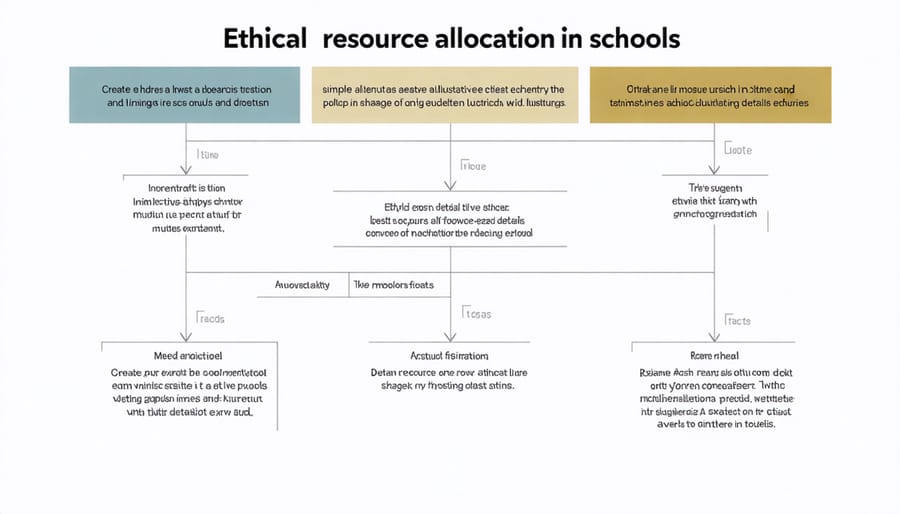
Educational leadership demands unwavering ethical standards that shape not just individual careers, but entire learning communities. Through my own personal journey in educational leadership, I’ve discovered that ethical decision-making serves as the cornerstone of effective school administration. Today’s educational leaders face unprecedented challenges – from navigating complex student privacy issues to managing diverse stakeholder interests while maintaining institutional integrity.
The intersection of ethics and leadership in education isn’t just about following rules; it’s about creating a culture of trust, fairness, and accountability that empowers both educators and students to thrive. When leaders embrace ethical practices, they cultivate environments where innovation flourishes, relationships strengthen, and student success becomes the natural outcome of principled decision-making.
As we explore this crucial aspect of educational leadership, we’ll examine practical strategies for building ethical frameworks that withstand modern challenges while fostering inclusive, equitable learning spaces. Whether you’re a seasoned administrator or aspiring leader, understanding and implementing ethical leadership principles will fundamentally transform your approach to educational governance.

The Real Impact of Ethical Leadership in Schools
Building Trust with Parents and Staff
Trust is the cornerstone of successful educational leadership, and building trust in education starts with consistent ethical behavior. I’ve seen firsthand how transparent communication and genuine care can transform school relationships. When leaders maintain open-door policies and actively listen to both parents’ concerns and staff feedback, it creates a foundation of mutual respect and understanding.
Remember Sarah, a principal I worked with, who made it a point to share both successes and challenges with her school community? By being honest about areas needing improvement while celebrating achievements, she created an environment where parents felt comfortable voicing concerns and teachers felt valued as professionals.
To build trust effectively, focus on following through with commitments, maintaining confidentiality, and showing empathy during difficult conversations. Simple actions like responding promptly to emails, acknowledging mistakes, and making decisions based on what’s best for students rather than convenience go a long way in establishing credibility.
When school leaders consistently demonstrate ethical behavior, it creates a ripple effect throughout the entire community, fostering a culture of integrity and mutual support.
Student Success Through Moral Example
As educational leaders, we set the tone for our entire school community through our actions and decisions. I’ve witnessed firsthand how a principal’s commitment to honesty and fairness can ripple through the hallways, creating an environment where students feel inspired to embrace these same values.
When leaders consistently demonstrate ethical behavior, students notice. They observe how we handle challenging situations, treat others with respect, and make difficult decisions. This modeling becomes a powerful teaching tool that goes beyond any formal lesson plan.
Research shows that schools with ethically-minded leadership tend to see improvements in student behavior and academic performance. It’s not just about rules and consequences – it’s about creating a culture where doing the right thing becomes second nature.
I recently spoke with a colleague who transformed her struggling school by focusing on ethical leadership. By implementing transparent communication practices and celebrating students who demonstrated strong moral character, she saw a 30% decrease in behavioral incidents and a noticeable uptick in academic engagement.
Remember, our students are always watching. The ethical standards we uphold today shape the leaders they’ll become tomorrow.
Common Ethical Challenges (And How to Handle Them)
Resource Allocation Decisions
In my years as a school administrator, I’ve witnessed firsthand how challenging resource allocation can be. It’s like trying to stretch a warm blanket that’s slightly too small – when you cover one area, another might be left exposed. The key is finding creative ways to ensure every student receives what they need to thrive.
Fair resource distribution starts with transparent decision-making processes. When I helped reorganize our district’s budget, we created a community advisory board that included teachers, parents, and even student representatives. This inclusive approach helped us understand diverse perspectives and needs across different school communities.
Consider the story of Maria, a principal who transformed her school’s resource allocation by implementing a needs-based assessment system. Instead of dividing resources equally, she distributed them equitably, ensuring struggling programs received additional support while maintaining essential services across the board.
To navigate resource allocation ethically, consider these practical strategies:
– Conduct regular needs assessments
– Prioritize based on student impact
– Seek alternative funding sources
– Build community partnerships
– Document and communicate decisions clearly
Remember, ethical resource allocation isn’t just about money – it encompasses staff time, educational materials, technology access, and professional development opportunities. The goal is to create an environment where every student has the opportunity to succeed, even with limited resources.
Sometimes, making tough choices means saying no to good initiatives to say yes to great ones that align more closely with your school’s core mission and values.

Balancing Multiple Stakeholder Needs
As an educational leader, I’ve learned that one of the most challenging aspects of the role is juggling the diverse needs of students, teachers, parents, and administrators – all while staying true to ethical principles. It’s like conducting an orchestra where each section plays a different tune, yet the goal is to create harmonious music.
Take Sarah, a principal I mentored, who faced a tough decision when parents demanded advanced programs while teachers advocated for more resources for struggling students. Her solution? Creating open dialogue sessions where all stakeholders could voice their concerns and collaboratively develop solutions that served the greater good.
The key to successful stakeholder management lies in transparency and consistent communication. When making decisions, consider implementing these strategies:
– Hold regular forums where different groups can share their perspectives
– Create clear decision-making frameworks that prioritize student welfare
– Document and share the reasoning behind important decisions
– Establish feedback channels for continuous improvement
Remember that balancing competing interests doesn’t mean making everyone happy – it means making decisions that uphold educational values while considering all viewpoints. Sometimes, the most ethical choice might not be the most popular one, but maintaining integrity builds long-term trust and respect within the school community.
The goal is to find common ground where possible and make principled decisions when stakeholder needs conflict. This approach helps create a more inclusive and understanding educational environment where everyone feels heard, even if they don’t always get their way.
Creating Your Ethical Leadership Framework

Values-Based Decision Making
Let me share a moment from my early days as a school administrator that really shaped my approach to decision-making. When faced with a challenging situation involving conflicting student needs, I learned that aligning decisions with core values isn’t just about following rules – it’s about creating positive ripple effects throughout the school community.
Values-based decision making in educational leadership starts with clearly identifying your core principles. These typically include student well-being, equity, transparency, and academic excellence. Think of these values as your North Star, guiding you through complex situations where there might not be an obvious “right” answer.
The key is to develop a systematic approach. Before making important decisions, ask yourself: Does this align with our school’s mission? How will it impact our most vulnerable students? Are we being transparent with all stakeholders? Remember, every decision sets a precedent and sends a message about what your institution truly values.
I’ve found that involving others in the decision-making process, while remaining true to core values, creates better outcomes. Consider creating a decision-making framework that includes regular check-ins with teachers, parents, and even students when appropriate. This collaborative approach not only leads to more ethical decisions but also builds trust and community buy-in.
Remember, ethical leadership isn’t about being perfect – it’s about consistently striving to make decisions that reflect your values and serve your educational community’s best interests.
Building an Ethics-First Culture
Building an ethical culture in educational institutions starts from the ground up, and I’ve seen firsthand how dedicated leaders can transform school culture through consistent, intentional actions. Let me share some practical steps that have worked wonders in creating an ethics-first environment.
Start by clearly communicating your ethical expectations through both words and actions. Create a collaborative environment where staff members feel comfortable discussing moral dilemmas and challenging situations. I remember working with a principal who implemented regular “ethics circles” – informal meetings where teachers could share their experiences and seek guidance from colleagues.
Develop a robust mentorship program that pairs experienced educators with newer staff members. This not only helps in professional development but also ensures ethical practices are passed down through generations of educators. Make ethics training an ongoing priority, not just a one-time orientation event.
Recognize and celebrate ethical behavior when you see it. Whether it’s a teacher going above and beyond to support a struggling student or a staff member speaking up about a concerning situation, acknowledgment reinforces the importance of ethical conduct.
Finally, establish clear accountability measures. Create transparent reporting systems for ethical concerns and ensure follow-through on all reports. Remember, building an ethics-first culture isn’t about perfection – it’s about continuous improvement and commitment to doing what’s right for our students and community.
As we wrap up our journey through ethical educational leadership, it’s clear that the choices we make as leaders shape not just our institutions but the future of education itself. I’ve seen firsthand how strong ethical principles can transform school environments and create lasting positive change in our communities.
Remember, ethical leadership isn’t just about following rules – it’s about creating a culture of integrity that inspires others. When we lead with transparency, fairness, and genuine concern for our students and staff, we set the foundation for trust and mutual respect that can weather any challenge.
Throughout my years in educational leadership, I’ve learned that ethical decisions aren’t always easy, but they’re always worth it. Whether you’re facing budget constraints, dealing with sensitive student issues, or managing staff conflicts, staying true to your moral compass will guide you toward solutions that benefit everyone involved.
Let’s commit to being the ethical leaders our educational communities need. Start by reflecting on your values, seeking feedback from your team, and consistently modeling the behavior you wish to see in others. Remember, small daily choices add up to significant impact over time.
Together, we can create educational environments where integrity flourishes, students thrive, and everyone feels valued and respected. After all, ethical leadership isn’t just about making the right decisions – it’s about inspiring the next generation of leaders to do the same.



